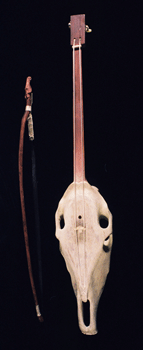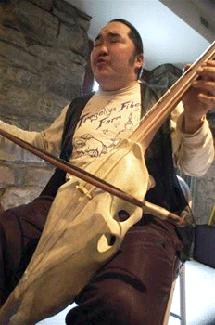

A Horse's Tale
This story about the igil was recounted by Oorzhak Kombu Chalzÿevich, born in 1917 in Aldan-Maadyr village, near Süt-Xöl (Milk Lake), in western Tuva. It involves Ösküs-ool, a hero of many Tuvan tales.


Long, long ago, there was a boy named Ösküs-ool, who lived with his father, a poor man in his declining years. All they owned were three goats. Ösküs-ool's master, an evil Mongolian prince, had a skinny old mare who, after giving birth to a colt one spring, died of exhaustion. The prince said, "I'm not willing to waste precious grass on an orphaned colt!" and ordered the young horse taken to the steppe and abandoned for wolves to eat.
Ösküs-ool felt sorry for the colt, so he took it home and fed it milk from his goats. The colt grew up to be a great gray stallion, a swift, strong steed with a white star on its forehead. Ösküs-ool's horse began to beat the evil prince's horse in races. It became a favorite of the people, and with each win became more famous throughout Tuva. This infuriated the evil prince, who in his envy and anger ordered his servants to steal Ösküs-ool's horse and push it over a high, overhanging cliff.
When Ösküs-ool discovered that his beloved horse was gone, he searched endlessly for it. Eventually he collapsed from exhaustion, and fell into a deep sleep. He dreamed of his horse, who approached him and spoke in a human voice:
"You will find my remains under the steep, overhanging cliff. Hang my skull on an old larch tree. Make a musical instrument from the wood of that tree, and call it 'igil.' Cover the igil with skin from my face; make the strings and the bow from the hair of my tail. When you start to play the igil, my double will come down from the Upper World."
Ösküs-ool woke up and did as the horse had told him in his dream. When he began to play his igil, he remembered the happy days when his beloved horse was a spindly colt romping on the grassy steppe, and how he had grown up to win so many races. His igil sounded happy. And when Ösküs-ool began to weep because his beloved horse was no longer alive, his igil wept with him as he played.
Ösküs-ool grew angry thinking about the evil prince, and his grief and anger found expression in the igil's music. Ösküs-ool played for a long, long time, and people from near and far came to listen. As they listened, the people laughed and wept with him.
Suddenly at the top of a high mountain the clouds divided, and down from the summit came a great, gray stallion with a white star on his forehead. The stallion was not alone: thundering down behind him came a whole herd of powerful horses, just like Ösküs-ool's, with black and white faces.

SOURCE: Deep in the Heart of Tuva CD with accompanying book, text by Ralph Leighton. Published by Ellipsis Arts in 1996, now out of print.
A variation of this story is recounted by Sarah Wallin in Tuvan Throat Singing and the Legend of the Horse Head Fiddle [PDF].